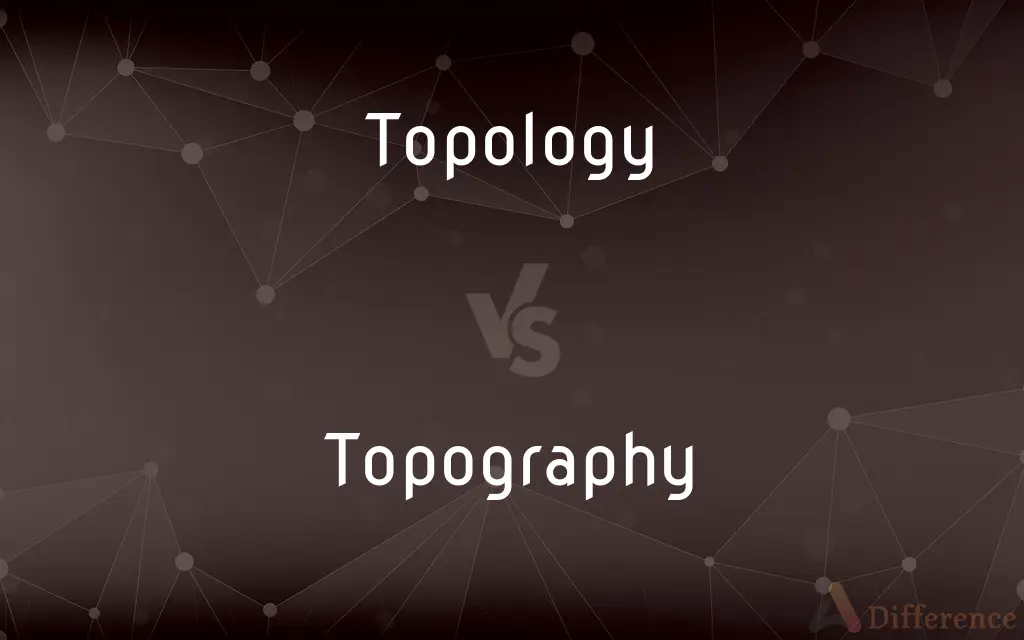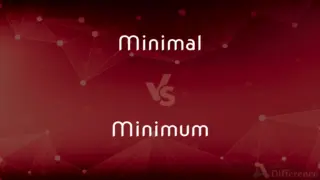Topology vs. Topography — What's the Difference?
Edited by Tayyaba Rehman — By Fiza Rafique — Updated on September 21, 2023
Topology refers to the study of properties and spatial relations unaffected by changes in shape. Topography is the study of the physical features, elevations, and contours of the Earth's surface.

Difference Between Topology and Topography
Table of Contents
ADVERTISEMENT
Key Differences
Topology is a branch of mathematics that focuses on the properties of space that remain unchanged under continuous transformations. It explores the spatial relationships between elements and is critical in various fields such as mathematics, computer science, and networking. Topography, on the other hand, pertains to the detailed representation of the physical features, elevations, and contours of the Earth's surface. It's widely used in cartography, surveying, and geology.
Topology deals with abstract concepts and doesn't necessarily require a physical context. It studies how a geometric object could be stretched or bent without changing its basic nature. Topography, in contrast, deals with tangible elements like mountains, rivers, and valleys. It maps these elements in relation to each other, providing a detailed account of a specific geographic area.
While topology can apply to any space or network with definable relations between its components, topography is strictly tied to the Earth's surface. For example, network topology in computer science refers to how computers are interconnected, which can differ vastly from the layout of a physical landscape. Topography, meanwhile, would be concerned with the heights and depressions on a landscape, and could never apply to a conceptual space like a network.
Topology often relies on complex mathematical equations to study spatial properties. It can be purely theoretical. Topography, however, involves more empirical methods like observation and measurement, often using instruments like theodolites and GPS systems to capture accurate data about the Earth's surface.
Comparison Chart
Field
Mathematics, Computer Science
Cartography, Surveying
ADVERTISEMENT
Focus
Spatial properties
Physical features, elevations
Application
Abstract or physical
Strictly physical
Methodology
Mathematical equations
Empirical, observational
Real-world or Abstract
Can be either
Always real-world
Compare with Definitions
Topology
Focuses on abstract spatial properties.
Topology investigates the essential characteristics of geometric shapes.
Topography
Used in cartography and surveying.
Topography is essential for accurate map-making.
Topology
Applicable to network design in computer science.
Network topology is crucial in optimizing data flow.
Topography
The study of Earth's surface features.
The topography of the area includes mountains and valleys.
Topology
Concerned with properties unaffected by continuous transformations.
In topology, a circle and an ellipse are considered equivalent.
Topography
Maps physical features relative to each other.
The topography map showed the river's course through the valley.
Topology
In mathematics, topology (from the Greek words τόπος, 'place, location', and λόγος, 'study') is concerned with the properties of a geometric object that are preserved under continuous deformations, such as stretching, twisting, crumpling, and bending; that is, without closing holes, opening holes, tearing, gluing, or passing through itself. A topological space is a set endowed with a structure, called a topology, which allows defining continuous deformation of subspaces, and, more generally, all kinds of continuity.
Topography
Topography is the study of the forms and features of land surfaces. The topography of an area could refer to the surface forms and features themselves, or a description (especially their depiction in maps).
Topology
The study of geometrical properties and spatial relations unaffected by the continuous change of shape or size of figures.
Topography
The arrangement of the natural and artificial physical features of an area
The topography of the island
Topology
The way in which constituent parts are interrelated or arranged
The topology of a computer network
Topography
The distribution of parts or features on the surface of or within an organ or organism.
Topology
Topographic study of a given place, especially the history of a region as indicated by its topography.
Topography
Detailed, precise description of a place or region.
Topology
(Medicine) The anatomical structure of a specific area or part of the body.
Topography
Graphic representation of the surface features of a place or region on a map, indicating their relative positions and elevations.
Topology
The study of certain properties that do not change as geometric figures or spaces undergo continuous deformation. These properties include openness, nearness, connectedness, and continuity.
Topography
A description or an analysis of a structured entity, showing the relations among its components
In the topography of the economy, several depressed areas are revealed.
Topology
The underlying structure that gives rise to such properties for a given figure or space
The topology of a doughnut and a picture frame are equivalent.
Topography
The surface features of a place or region.
Topology
(Computers) The arrangement in which the nodes of a network are connected to each other.
Topography
The surface features of an object
The topography of a crystal.
Topology
The branch of mathematics dealing with those properties of a geometrical object (of arbitrary dimensionality) that are unchanged by continuous deformations (such as stretching, bending, etc., without tearing or gluing).
Topography
The surveying of the features of a place or region.
Topology
(topology) Any collection τ of subsets of a given set X that contains both the empty set and X, and which is closed under finitary intersections and arbitrary unions.
A set equipped with a topology is called a topological space and denoted .
The subsets of a set which constitute a topology are called the open sets of .
Topography
The study or description of an anatomical region or part.
Topology
(medicine) The anatomical structure of part of the body.
Topography
A precise description of a place.
Topology
(computing) The arrangement of nodes in a communications network.
Topography
A detailed graphic representation of the surface features of a place or object.
Topology
(technology) The properties of a particular technological embodiment that are not affected by differences in the physical layout or form of its application.
Topography
The features themselves; terrain.
Topology
(topography) The topographical study of geographic locations or given places in relation to their history.
Topography
The surveying of the features.
Topology
(dated) The art of, or method for, assisting the memory by associating the thing or subject to be remembered with some place.
Topography
(by extension) A figurative landscape; a structure of interrelated ideas, etc.
Topology
The art of, or method for, assisting the memory by associating the thing or subject to be remembered with some place.
Topography
The description of a particular place, town, manor, parish, or tract of land; especially, the exact and scientific delineation and description in minute detail of any place or region.
Topology
A branch of mathematics which studies the properties of geometrical forms which retain their identity under certain transformations, such as stretching or twisting, which are homeomorphic. See also topologist.
Topography
The configuration of a surface and the relations among its man-made and natural features
Topology
Configuration, especially in three dimensions; - used, e. g. of the configurations taken by macromolecules, such as superhelical DNA.
Topography
Precise detailed study of the surface features of a region
Topology
Topographic study of a given place (especially the history of place as indicated by its topography);
Greenland's topology has been shaped by the glaciers of the ice age
Topography
Concerned with elevations and depressions.
Topography maps often indicate altitude.
Topology
The study of anatomy based on regions or divisions of the body and emphasizing the relations between various structures (muscles and nerves and arteries etc.) in that region
Topography
Involves empirical methods and observation.
Topography requires fieldwork and data collection.
Topology
The branch of pure mathematics that deals only with the properties of a figure X that hold for every figure into which X can be transformed with a one-to-one correspondence that is continuous in both directions
Topology
The configuration of a communication network
Topology
A branch of mathematics studying spatial relations.
Topology explores the fundamental aspects of spatial relationships.
Topology
Can be theoretical or practical.
Topology has applications ranging from pure mathematics to real-world engineering.
Common Curiosities
Is topography practical or theoretical?
Topography is generally practical and observational.
What is topology?
Topology is the study of properties of space that remain constant under continuous deformations.
Do you need to know math for topology?
Topology usually involves complex mathematical concepts.
Are there subfields of topology?
Yes, such as algebraic topology and geometric topology.
What is topography?
Topography is the study of Earth's physical features and their elevations.
Is topology a branch of mathematics?
Yes, topology is primarily a field within mathematics.
Is topography limited to Earth sciences?
Topography mainly focuses on Earth sciences like geology and cartography.
What are the applications of topography?
Applications include map-making, surveying, and land use planning.
How does topology differ from geometry?
Topology is less concerned with measurements and more with spatial relations that stay the same under transformations.
What does topography map?
It maps the physical features, elevations, and depressions of a landscape.
Is topography always real-world?
Topography is always concerned with real-world physical features.
Can topology be used in data science?
Yes, topology has applications in data analysis and machine learning.
Can topology be applied to computer science?
Yes, network topology is a concept in computer science.
Can topology apply to any space?
Yes, topology can apply to any well-defined space, real or conceptual.
Do you need instruments for topography?
Yes, instruments like theodolites are often used in topographical studies.
Share Your Discovery

Previous Comparison
Minimal vs. Minimum
Next Comparison
Led vs. LeadAuthor Spotlight
Written by
Fiza RafiqueFiza Rafique is a skilled content writer at AskDifference.com, where she meticulously refines and enhances written pieces. Drawing from her vast editorial expertise, Fiza ensures clarity, accuracy, and precision in every article. Passionate about language, she continually seeks to elevate the quality of content for readers worldwide.
Edited by
Tayyaba RehmanTayyaba Rehman is a distinguished writer, currently serving as a primary contributor to askdifference.com. As a researcher in semantics and etymology, Tayyaba's passion for the complexity of languages and their distinctions has found a perfect home on the platform. Tayyaba delves into the intricacies of language, distinguishing between commonly confused words and phrases, thereby providing clarity for readers worldwide.













































